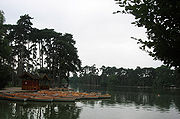Bois de Boulogne
From Wikipedia, the free encyclopedia
The Bois de Boulogne is a park located along the western edge of the 16ème arrondissement of Paris, near the suburb of Boulogne-Billancourt.
The Bois de Boulogne has an area of 8.459 km² (3.266 sq. miles, or 2,090 acres), which is 2.5 times larger than Central Park in New York, and 3.3 times larger than Hyde Park in London.
At night time, the area welcomes a different scene, and becomes one of Paris' most prominent red-light districts.
The northern part of the Bois is occupied by the Jardin d'Acclimatation, a kind of amusement park with a menagerie and other attractions.
Contents |
[edit] History
These "Boulogne Woods" are a remnant of the ancient oak forest of Rouvray,[1] which was first mentioned in 717, in the charter of Compiègne. The lands were given by Childeric II to the powerful Abbey of Saint-Denis, which founded a number of monasteries in the woodlands. Philip Augustus bought back the main part of the forest from the monks of St Denis to create a royal hunting reserve on Crown lands. In 1256, Isabelle de France, sister of Saint-Louis, founded Longchamp.
During the Hundred Years' War, the forest became the haunt of robbers; in 1416-17 troops of the Duke of Burgundy burned part of Rouvroy Forest; Under Louis XI, the estate, now called the Bois de Boulogne, was reforested and two roads were opened through it.
After François I built the Château de Madrid (completed 1526) in the Bois de Boulogne, the woodlands became a site of festivities, though highwaymen could make the roads that led through it dangerous: the intrepid voyager Pierre Belon was murdered by thieves in the Bois de Boulogne in 1564.[2] The hunting park was enclosed by walls under Henri II and Henri III, with eight gates. Henri IV planted 15000 mulberry trees, with the hope of instigating a local silk industry. His repudiated wife Marguerite de Valois retired to her refuge in the Château de la Muette, in the Bois. In November 1783, from the grounds of the Château de la Muette, Pilâtre de Rozier and the Marquis d'Arlandes made the first successful manned flight in a hot-air balloon built by the Montgolfier brothers.

In the Bois the Comte d'Artois, Louis XVI's brother,built the Château de Bagatelle. The site was made into a park by Napoleon III in 1852, and, financed by selling building lots along the north end of the Bois, in Neuilly,[3] it was landscaped under the direction of the Baron Haussmann; in the following years it was informally landscaped with open lawns and woodlands of hornbeam, beech, linden, cedar, chestnut and elm trees and hardy exotic species, like redwoods. Some aspects of the transformmations were clearly the result of Louis Napoléon's exile in London: '"we must have a stream here, as in Hyde Park," he observed while driving through the Bois, "to give life to this arid promenade".[4]All the formal allées, with the exceptions of the Allée Reine Marguerite and the Avenue Longchamp were made serpentine: there are thirty-five kilometres of footpaths, eight kilometres of cycle paths and twenty-nine kilometres of riding tracks. The upper and lower lakes, connected by a waterfall, were created; the excavated earth was used to create the Butte Mortemart. Between 1855 and 1858, the Hippodrome de Longchamp was built on the plain of the same name.
The Bois de Boulogne was officially annexed by the city of Paris in 1929, and was incorporated into the 16ème arrondissement. (Like the Bois de Vincennes, it is however generally not counted as part of Paris proper, since it only consists of public land with no population except for custodians.)
[edit] Notes
- ^ Its name is commemorated in the communes of Rouvray-Catillon and Rouvray-St-Denis.
- ^ Serge Sauneron, ed. Belon, Le Voyage en Égypte de Pierre Belon du Mans 1547, (Cairo 1970) Introduction.
- ^ J. M. Chapman and Brian Chapman , The Life and Times of Baron Haussmann: Paris in the Second Empire (Weidenfeld & Nicholson) 1957:89.
- ^ Charles Merruau, Souvenirs dde l'Hôtel de Ville de Paris, 1848-1852 (Paris 1875:37), quoted in David H. Pinkney, 'Napoleon III's Transformation of Paris: The Origins and Development of the Idea" The Journal of Modern History 27.2 (June 1955:125-134) p 126.
[edit] See also
- Château de Bagatelle
- Bois de Vincennes
- Bois de Boulogne: city in mountain region of Lebanon (arabic: Ghābat Būlūnyā), 33 km from Beirut
[edit] References
- Michael Oborne, "History of the Château de la Muette" in the Bois de Boulogne
- Jocelen Janon, "A Brief History of Bagatelle" in the Bois de Boulogne




